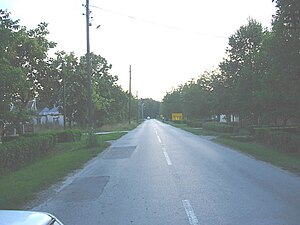Opovo
|
Opovo Опово |
|
|---|---|
| Town and municipality | |

A street in Opovo
|
|
| Location of Opovo within Serbia | |
| Coordinates: 45°3′7″N 20°25′49″E / 45.05194°N 20.43028°ECoordinates: 45°3′7″N 20°25′49″E / 45.05194°N 20.43028°E | |
| Country |
|
| Province | Vojvodina |
| District | South Banat |
| Government | |
| • Mayor | Milorad Soldatović |
| Elevation | 67 m (220 ft) |
| Population (2011) | |
| • Opovo | 4,546 |
| • Metro | 10,475 |
| Time zone | CET (UTC+1) |
| • Summer (DST) | CEST (UTC+2) |
| Postal code | 26204 |
| Area code(s) | +381(0)13 |
| Car plates | PA |
| Website | www.opovo.org.rs |
Opovo (Serbian Cyrillic: Опово) is a town and municipality located in the South Banat District of the autonomous province of Vojvodina, Serbia. The town has a population of 4,546, while Opovo municipality has 10,475 inhabitants.
In Serbian, the town is known as Opovo (Опово), in German as Opowa, in Hungarian as Ópáva, in Croatian as Opovo, in Romanian as Opovo, in Slovak as Opovo, and in Rusyn as Опово.
There are traces from Neolithic and Roman periods in this area. An older settlement named Želj existed at this locality during medieval Hungarian and later Ottoman administration. During Hungarian administration it was part of the Kovin county and during Ottoman administration part of the Temeşvar Eyalet. Southern part of modern Opovo is still called Želj by local inhabitants. According to historical sources, modern Opovo was mentioned first in 1672-1690 and it was populated by Serbs. They lived in the houses made from mud. During Ottoman administration, settlement had 27 houses and, after Habsburg conquest, in 1717, it had 64 houses.
During Habsburg administration, Opovo firstly was part of the Banat of Temeswar (until 1751) and then part of the Habsburg Military Frontier. In 1753, Opovo was recorded as ethnic Serb settlement. In the second half of the 18th century (in 1769), Germans and Hungarians settled in Opovo. Serb elementary school in Opovo was opened in 1768, while German school was opened around 1773-4. Construction plan from 1776 predicted that 225 Serb and 60 Catholic houses would be built in the settlement. In 1782, settlement had population of 1,497 people. In the first half of the 19th century (1829–1831), Serbian Orthodox church of Saint Nikolaj was built. In 1848-1849, Opovo was part of autonomous Serbian Vojvodina, but was returned under military administration in 1849. With the abolishment of Military Frontier in Banat (in 1873), Opovo was included into Torontál County, which was part of the Habsburg Kingdom of Hungary and Austria-Hungary. In 1885, new elementary school was elevated in the settlement. In 1910, Serbs were in an absolute majority in Opovo, while other ethnic groups that lived in the settlement included Germans, Croats and Hungarians.
...
Wikipedia

